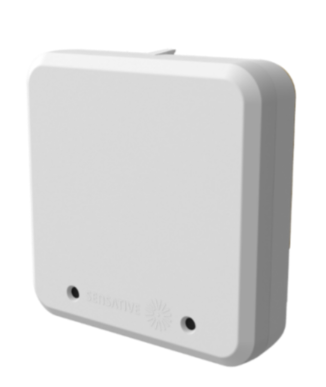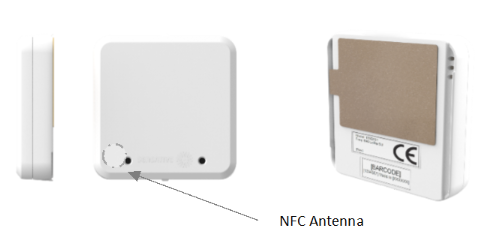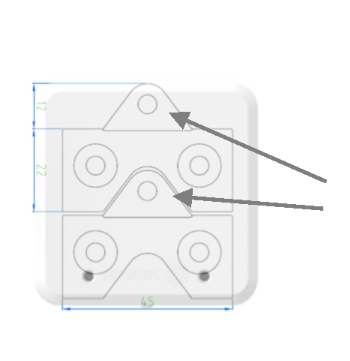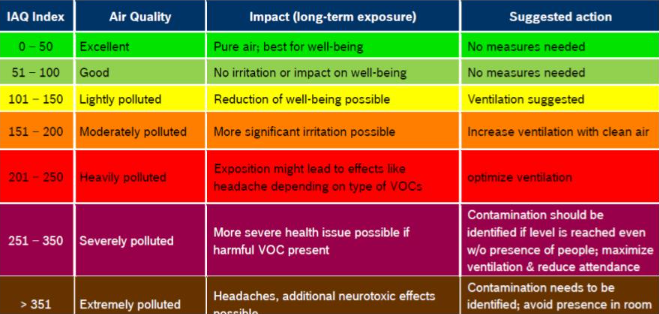Square Air

Description
Square AIR is a state-of-the-art indoor air quality sensor, offering advanced capabilities over traditional CO2 sensors. This compact and discreet unit, measuring 58 x 58 x 15 mm, is equipped with a long-lasting 6 Ah battery, ensuring up to 7 years of continuous operation or up to 15 years continuous use during extended office hours only (e.g.Mon-Fri 06.00-20.00).
It features the groundbreaking Bosch BME688 gas sensor, an AI-powered digital nose, capable of detecting a range of gases including VOCs, VSCs, carbon monoxide, and hydrogen.
Square AIR calculates IAQ, bVOC, and CO2 equivalents (CO2e), while also measuring temperature, humidity, barometric pressure, and ambient light. Equipped with NFC for easy configuration, LoRaWAN for long-range communication and WiFi MAC address scanning for indoor positioning makes it easy to use Square AIR.
The Square AIR, with its advanced digital nose sensor, serves as a key component in securing healthy work and living conditions within buildings. Its precise detection of various air substances enables effective ventilation strategies, aiding in energy cost reduction and minimizing environmental impact. The sensor's versatility opens new avenues for specialized applications, making it an essential tool in intelligent buildings.
Benefits & Use Cases
Square AIR is ideal for larger properties such as offices, meeting rooms, training facilities, and residential buildings, offering versatility through various configuration profiles. Its advanced sensor technology goes beyond traditional CO2 detection, measuring a wide range of air pollutants to enhance indoor air quality management. Equipped with AI tools, it can be customized to detect specific substances. The sensor’s suite, including temperature, humidity, barometric pressure, and ambient light sensing, along with NFC, LoRaWAN connectivity and the in-door geo-positioning feature using WIFI MAC address scanning, make it a comprehensive solution for smart building management.
Square AIR also has the capability to detect smoke, contributing to early fire prevention, though it is important to note that it is not a certified fire alarm.
It should be emphasized that Square AIR is not designed to detect CO2 leaks from gas cylinders or other equipment, making it unsuitable for applications related to CO2 leak detection.
Mechanics
The Square AIR is a highly compact air quality sensor, with dimensions of 58 x 58 x 15 mm, designed for discreet mounting. It can be easily attached using adhesive or screws. Square AIR is equipped with a built-in, non-rechargeable battery, intended for the entire lifespan of the device, emphasizing its low-maintenance and user-friendly design.

Figure 1: Square Air
Software
Square AIR's advanced software architecture includes a Virtual Sensing Machine (VSM) within its firmware. This VSM operates specialized sensor applications that align with the device's sensing capabilities and specific use scenarios. Square AIR is delivered with a general-purpose application that can be adapted to a wide range of applications by using different configuration profiles to optimize battery life according to the specific application. Sensative offers customized application development services and AI trained gas scanning profiles for specific substances, enabling Square AIR to meet very specialized requirements and enhance performance in various environments.
Getting started
Initial Setup & Activation (OTAA)
Pre-Activation Steps:
- Prior to activating the device, ensure it is registered on the designated LoRaWAN server.
- Utilize the Dev EUI and Network Key provided with your digital delivery information for registration.
Activation:
- Following registration, briefly bring any NFC reader close to the device to initiate activation. Most mobile phones are equipped to serve as NFC readers. Just ensure that NFC is enabled in your phone settings.
- The activation process might take up to two minutes. Successful join activity will be indicated on the LoRaWAN Network Server.
- The device will continuously attempt the activation process until it successfully connects to the registered LoRaWAN network. Joining the network might take up to 24 hours once the LoRaWAN network becomes available.
Configuration:
- Tailor the device settings to fit your specific use case.
- Multiple configuration options are available. 3. Configuration support: https://sensative.com/resource-center/
Installation
When installing Square AIR, it's crucial to position the sensor at eye level in the room to ensure the measurements are representative of the space. The location should have good air circulation. Avoid mounting the sensor near trash cans, chemicals, ventilation inlets, doors, or windows, as these could significantly affect the sensor's ability to accurately measure the room's air quality. This strategic placement will help in providing more reliable and meaningful air quality data.
Square AIR can be mounted using the included adhesive for a secure and straightforward installation. When installing the Square Tracker with adhesive, it's important to first clean the mounting surface. Use a 50:50 mixture of isopropyl alcohol (IPA) and water to ensure the surface is free of dirt and grease, which helps in securing strong adhesion of the tracker.
If you prefer screw mounting, the device accommodates M3 screws. It's recommended to use washers to prevent damaging the screw ears, which can be easily twisted off if not using screws.
The device also offers an additional mounting option using thin, 2 mm adhesive plates. These plates allow for flexible installation, enabling the device to be secured with screws either behind or adjacent to its position. The adhesive plates come attached to a foil, as depicted in the left image below, which aids in accurately marking the drill points for screws beside the device, illustrated by the arrows indicating the relevant holes in the picture below. For installations requiring screws behind the device, position the plates as illustrated in the right image below, and utilize ultra-low profile flat head screws, such as EJOT 905224 (available through Sensative), for a seamless fit.
To proceed with the installation, after marking and drilling the necessary holes, attach the plates using screws in the designated positions, ensuring the thick adhesive side is facing towards you. Next, peel off the protective films from the plate and device adhesives, verify the plates are correctly aligned, and then firmly press the device onto the plates for a secure attachment.

Figure 3: Adhesive plates for mounting with screws. Use the holes pointed out for adjacent (left) or hidden (right figure) screw installation.
For removal of a device mounted with adhesive, dental floss is the best tool. Simply slide the floss behind the sensor and use a sawing motion to gently cut through the adhesive, detaching the device without causing damage.
Operations
The Square AIR sensor operates efficiently, lasting up to 7 years in the BME688 Ultra Low Power (ULP) mode, which conducts gas scanning every 5 minutes. To further extend its operational life, the sensor can be configured to enter standby mode during non-essential periods, such as outside working hours. Additionally, it can be set to measure only at specific times of the day or solely when the room is lit, optimizing battery usage while ensuring effective air quality monitoring.
Please note that it takes up to 28 days of gas sensor operations to get fully reliable IAQ and gas sensor data. The status of this initial calibration and stabilization is indicated by the “Stabilization time status” data output.
The IAQ scale ranges from 0 (clean air) to 500 (heavily polluted air). During operations, the sensor algorithms automatically calibrate and adapt themselves to the typical environments where the sensor is operated (e.g. home, office, etc.). This automatic background calibration ensures consistent IAQ performance. The calibration process considers the recent measurement history to ensure that IAQ ~50 corresponds to good air and IAQ ~200 indicates typical polluted air. The sensor should be exposed to fresh air (well ventilated) on a weekly basis to ensure proper calibration. The Accuracy Status value (0-3) indicates the accuracy of the current calibration value.
The static IAQ value is not affected by the continuous auto-trimming algorithm and should be used if the device is not exposed to fresh air regularly.
IAQ, bVOC and CO2e sensor values are affected by air contaminations such as cooking, food, smoke, perfume, or outgassing from paint or furniture.
More information
- Default Square AIR application documentation incl configuration options
- Read more about Square Airs gas sensor from Bosch
- VSM Config Tool
- Support resource center
Technical information
| Specification | Description |
|---|---|
| Features | Cloud supported WIFI MAC address scanning and geo-positioning for in-door usage. Air quality sensor (IAQ) Gas sensor measuring the sum of VOCs and contaminants in the surrounding air. Temperature, air pressure, humidity and ambient light sensors LoRaWAN connectivity NFC (Near field communication) |
| Sensor data | Temperature sensor (Sensirion STS40) Temperature accuracy: +/- 0.2 ° C (typ) Ambient light sensor (Avago APDS-9306) Range: 1-65 000 Lux Human eye spectral response 50/60 Hz light flicker immunity Air quality sensor (Bosch BME688) Humidity accuracy: +/- 3% r.H. (range 10 - 90 % r.H.) Air pressure absolute accuracy: +/- 0.6 hPa (range 300 – 1100 hPa) Air pressure relative accuracy: +/- 0.12 hPa (range 900 – 1100 hPa) IAQ (Index Air Quality) range: 0 - 500. (recommended for mobile applications) S-IAQ (Static Index Air Quality): 0 – 500 (recommended for stationary devices) Sensor to sensor IAQ deviation: +/- 15% CO2 equivalents (ppm): Estimated CO2 derived from the average correlation between VOCs and CO2 in humans exhaled breath. b-VOC equivalents (ppm): Converted into breath-VOC equivalents in ppm concentration. For more info refer to Bosch BME688 data sheet. Gas scan result (%): Indicate the probability of H2S (gas_estimate_1) and non H2S (gas_estimate_2). Up to 4 scan classes can be used in customized Square AIR versions detect specific compounds in the air. Extracted information from Bosch BME688 data sheet. "The BME688 sensor is a metal oxide-based sensor that detects gases by absorption and subsequent oxidation/reduction on its sensitive layer. The intensity of the signal typically scales with the chemical reactivity of the gases. BME688 reacts to most volatile compounds as well as many other gases polluting indoor air (exceptions are very few gases which are chemically pretty inert, e.g. N2 and CO2). In contrast to sensors selective for one specific component, the BME688 is capable of measuring the sum of VOCs/contaminants in the surrounding air. This enables the BME688 to detect e.g. outgasing from paint, furniture and/or garbage, high VOC levels due to cooking, food consumption, exhaled breath and/or sweating. The IAQ scale ranges from 0 (clean air) to 500 (heavily polluted air). During operations, the algorithms automatically calibrate and adapt themselves to the typical environments where the sensor is operated (e.g. home, workplace, inside a car, etc.). This automatic calibration ensures that the users experience consistent IAQ performance. The calibration process considers the recent measurement history to ensure that IAQ ~50 corresponds to “typical good” air and IAQ ~200 indicates “typical polluted” air. IAQ (“IAQ” is especially recommended for mobile applications since the calibration algorithm automatically adopts to different environments Static IAQ (“s-IAQ”) is especially recommended for stationary devices (without calibration algorithm)"  |
| LoRaWAN specifications | Regions: * EU (863-870 MHz) * More regions will follow. Up to +14 dBm output power Up to 10 km range LoRaWAN v1.0.4 OTAA (Over The Air Activation & Configuration) A-OTA (Application Upgrade Over The Air) Multiple LoRaWAN network keys for sensor-initiated roaming |
| Geo-positioning specifications | The device supports the following geo-positioning services - 2.4 GHz WIFI (b/g/n) MAC address scanning - LoRa TDoA (Time Difference on Arrival) A geo-solving cloud service is required for geo-positioning. |
| Dimensions | 58 * 58 * 15 mm Weight: 65 g incl battery |
| Operating conditions | -20 to + 65° C, 10 – 90 % r.H. |
| Recommended storage conditions | +10 to + 30° C |
| Power supply | Built-in 6.0 Ah Li-MnO2 battery. 3.0 V |
| Battery life | Estimated 6-7 years battery life with continuous air quality measurements and quarterly reporting with a good LoRaWAN network coverage (SF7-8). Battery lifetime can be significantly extended by configuring the sensor to measure only when needed for the application. |
| NFC | 13.56 MHz Range: approx 2 cm. Position your NFC enabled phone directly in front of Square AIR’s lower left corner. See figure 1. Optional Android app for local configuration and data monitoring (password protected) |
| Other | * Reporting is configurable for periodic reporting, periodic average reporting, delta reporting, and threshold-based alarm reporting and more. * Supports battery reporting. * Data memory for off-line storage of time-stamped data |
Safety & Compliance
Square AIR contains a replaceable primary Li-MnO2 battery. The device should be disposed as a battery for recycling.
Li-MnO2 batteries are in general a safe battery technology but should still be handled with care. Do not short circuit, puncture, or expose to temperature above +80° C.
Note: This equipment has been tested and found to comply with the limits for a Class B digital device, pursuant to part 15 of the FCC Rules. These limits are designed to provide reasonable protection against harmful interference in a residential installation. This equipment generates, uses and can radiate radio frequency energy and, if not installed and used in accordance with the instructions, may cause harmful interference to radio communications. However, there is no guarantee that interference will not occur in a particular installation. If this equipment does cause harmful interference to radio or television reception, which can be determined by turning the equipment off and on, the user is encouraged to try to correct the interference by one or more of the following measures:
- Reorient or relocate the receiving antenna.
- Increase the separation between the equipment and receiver.
- Connect the equipment into an outlet on a circuit different from that to which the receiver is connected.
- Consult the dealer or an experienced radio/TV technician for help
FCC NOTICE (for USA):
This device complies with Part 15 of the FCC Rules. Operation is subject to the following two conditions: (1) this device may not cause harmful interference, and (2) this device must accept any interference received, including interference that may cause undesired operation. Federal Communication Commission (FCC) Radiation Exposure Statement: This equipment complies with FCC radiation exposure limits set forth for an uncontrolled environment. In order to avoid the possibility of exceeding the FCC radio frequency exposure limits, human proximity to the antenna shall not be less than 20cm (8 inches) during normal operation. The antenna(s) used for this transmitter must not be co-located or operating in conjunction with any other antenna or transmitter. No changes shall be made to the equipment without the Company’s permission as this may void the user’s authority to operate the equipment.
INDUSTRY CANADA STATEMENTS:
This device complies with Industry Canada licence exempt RSS standard(s). Operation is subject to the following two conditions: (1) this device may not cause interference, and (2) this device must accept any interference, including interference that may cause undesired operation of the device. This equipment complies with the safety requirements for RF exposure in accordance with RSS-102 §2.5.2. This equipment must be installed and operated in accordance with the provided instructions and a minimum 20 cm spacing must be provided between the antenna and any person’s body during wireless modes of operation.
INDUSTRY CANADA STATEMENTS:
Cet appareil est conforme avec Industrie Canada exempt de licence Rss standard(s). Son fonctionnement est soumis aux deux conditions suivantes : (1) cet appareil ne peut causer d’interférences, et (2) cet appareil doit accepter toute interférence, y compris des interférences qui peuvent provoquer un fonctionnement indésirable du périphérique. Ce dispositife est conforme à la norme de sécurité en matière d’exposition RF conformé-ment à la RSS-102 §2.5.2. Ce dispositif doit être installé et utilisé conformément aux instructions fournies et à 20 cm espacement minimal doit être prévu entre l’antenne et le corps de toute personne pendant les modes sans fil de fonctionnement.
INDUSTRY CANADA NOTICE
“This device complies with ISED’s licence-exempt RSSs. Operation is subject to the following two conditions: (1) This device may not cause interference; and (2) This device must accept any interference, including interference that may cause undesired operation of the device”